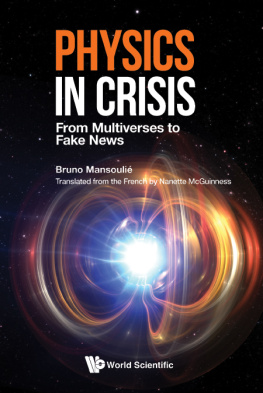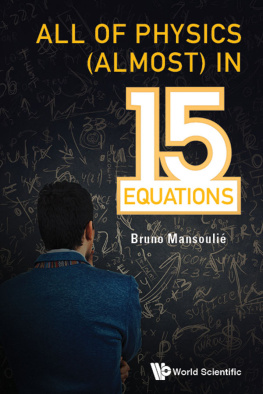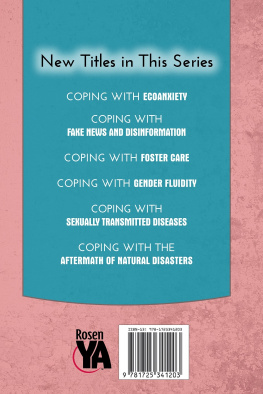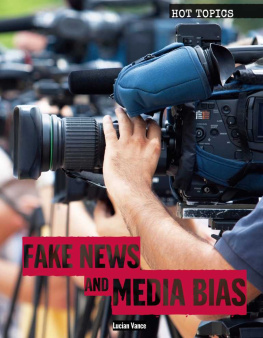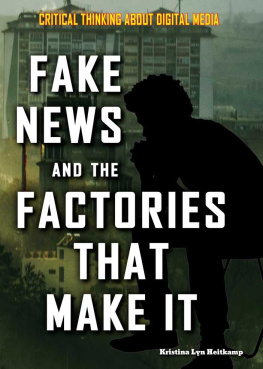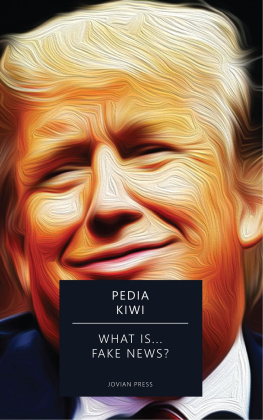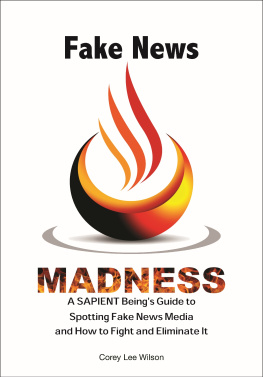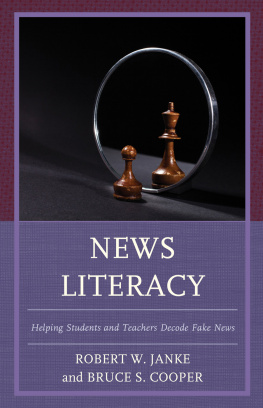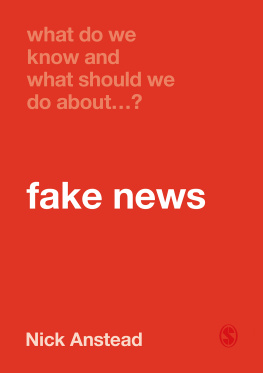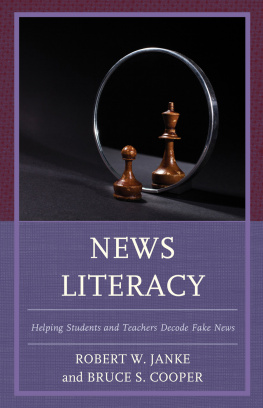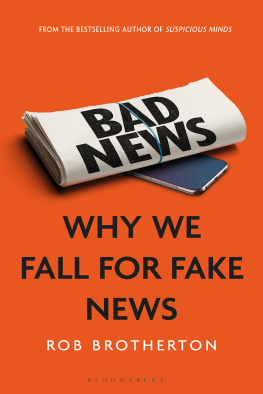Bruno Mansoulie - Physics In Crisis: From Multiverses To Fake News
Here you can read online Bruno Mansoulie - Physics In Crisis: From Multiverses To Fake News full text of the book (entire story) in english for free. Download pdf and epub, get meaning, cover and reviews about this ebook. year: 2022, publisher: World Scientific Publishing Company, genre: Romance novel. Description of the work, (preface) as well as reviews are available. Best literature library LitArk.com created for fans of good reading and offers a wide selection of genres:
Romance novel
Science fiction
Adventure
Detective
Science
History
Home and family
Prose
Art
Politics
Computer
Non-fiction
Religion
Business
Children
Humor
Choose a favorite category and find really read worthwhile books. Enjoy immersion in the world of imagination, feel the emotions of the characters or learn something new for yourself, make an fascinating discovery.
- Book:Physics In Crisis: From Multiverses To Fake News
- Author:
- Publisher:World Scientific Publishing Company
- Genre:
- Year:2022
- Rating:4 / 5
- Favourites:Add to favourites
- Your mark:
- 80
- 1
- 2
- 3
- 4
- 5
Physics In Crisis: From Multiverses To Fake News: summary, description and annotation
We offer to read an annotation, description, summary or preface (depends on what the author of the book "Physics In Crisis: From Multiverses To Fake News" wrote himself). If you haven't found the necessary information about the book — write in the comments, we will try to find it.
Physics In Crisis: From Multiverses To Fake News — read online for free the complete book (whole text) full work
Below is the text of the book, divided by pages. System saving the place of the last page read, allows you to conveniently read the book "Physics In Crisis: From Multiverses To Fake News" online for free, without having to search again every time where you left off. Put a bookmark, and you can go to the page where you finished reading at any time.
Font size:
Interval:
Bookmark:

PHYSICS
IN CRISIS
From Multiverses to
Fake News
PHYSICS
IN CRISIS
From Multiverses to
Fake News
Bruno Mansouli
Universit Paris-Saclay, CEA, France
Translated from the French by Nanette McGuinness

Published by
World Scientific Publishing Europe Ltd.
57 Shelton Street, Covent Garden, London WC2H 9HE
Head office: 5 Toh Tuck Link, Singapore 596224
USA office: 27 Warren Street, Suite 401-402, Hackensack, NJ 07601
Library of Congress Cataloging-in-Publication Data
Names: Mansoulie, Bruno, author.
Title: Physics in crisis : from multiverses to fake news / Bruno Mansoulie,
Universite Paris-Saclay, CEA, France ; translated from the French by Nanette McGuinness.
Other titles: Physique en crises. English
Description: New Jersey : World Scientific, [2023] | Includes index.
Identifiers: LCCN 2022006839 | ISBN 9781800612341 (hardcover) |
ISBN 9781800612358 (ebook for institutions) | ISBN 9781800612365 (ebook for individuals)
Subjects: LCSH: Physics--Philosophy.
Classification: LCC QC6 .M329513 2023 | DDC 530.01--dc23/eng20220422
LC record available at https://lccn.loc.gov/2022006839
British Library Cataloguing-in-Publication Data
A catalogue record for this book is available from the British Library.
Copyright 2023 by World Scientific Publishing Europe Ltd.
All rights reserved. This book, or parts thereof, may not be reproduced in any form or by any means, electronic or mechanical, including photocopying, recording or any information storage and retrieval system now known or to be invented, without written permission from the Publisher.
For photocopying of material in this volume, please pay a copying fee through the Copyright Clearance Center, Inc., 222 Rosewood Drive, Danvers, MA 01923, USA. In this case permission to photocopy is not required from the publisher.
For any available supplementary material, please visit
https://www.worldscientific.com/worldscibooks/10.1142/Q0364#t=suppl
Desk Editors: Jayanthi Muthuswamy/Adam Binnie/Shi Ying Koe
Typeset by Stallion Press
Email:
Printed in Singapore
S cience and technology have never been a larger part of daily life than they are today. All over the planet, even in the most remote areas, people carry smartphones incredible amalgamations of the latest scientific advances that incorporate electronics (which are based on Quantum Theory) and GPS systems (which communicate with satellites and contain a correction from General Relativity). Technology has, indeed, become ubiquitous in modern society. However, this amazing effectiveness cannot hide the fact that science, particularly physics, is facing three major crises.
The first crisis affects all of science and is social in nature. The problem? The gap between science and the public has never been as wide as it is now. At a minimum, people take science for granted and pay little attention to the progress made or questions asked. Or people are concerned about its negative implications, rightfully questioning the risks and impact of technology on their way of life. At worst, people reject science and embrace all kinds of beliefs and fake facts, such as the flat Earth hypothesis, to only name one.
The second is specific to fundamental physics. We have long known that our understanding of physics is flawed, or at least incomplete. Observations of the cosmos at very large distances show that something exists (so-called dark matter and dark energy) something not described by our current theories. In terms of pure theory, we are facing several major problems, of which the most blatant is that our two most foundational theories Quantum Theory and General Relativity are incompatible.
Despite this incompatibility, physics remains an effective means of exploring our environment and the universe from the smallest scale (particles) to the largest (cosmology). Still, these problems have now been with us for quite a while; numerous attempts to solve them (such as the well-known Superstring Theory) have failed, and experiments have not yielded any clues toward a possible solution.
Are we, therefore, stuck with this impasse?
Perhaps or perhaps not. One recent development and also the third crisis is neither an advance in theory nor an unexpected observation: rather it is the rise of artificial intelligence, in particular, machine learning and big data. AI is already a game-changer in all of our lives, and it could soon be one for the way we do science as well. This could lead to a serious crisis if it forces us to abandon our cherished theories for black box algorithms.
Yet the seeds of a solution to the first two crises may lie in this third one: AI could also lead to an answer or part of one. As people become more and more accustomed to algorithms and their not-so-obscure operations, the gap between the public and science may well narrow. Maybe the public will even find AI easier to comprehend than Quantum Theory and General Relativity!
As for the internal crisis in physics, AI algorithms may provide the missing link between our theories and observations. This link would not necessarily be a large Aha! advance, such as those made by Newton or Einstein. But who says that we will always solve the problems in physics with an Aha theory?
Before we address such deep, thorny questions, it might be good to start with much simpler ones: how do we represent the world around us? What is a theory in physics, and further, what is a good theory?
Using simple language and insightful examples, Physics in Crisis begins with these basic questions and then turns to the more complex ones. The author ends with his own, personal viewpoint, a call to: reinstate the values of Enlightenment; take advantage of these crises to reconcile the public with science; foster a renewed appreciation of the beauty of science; and espouse a rationalist spirituality!

Bruno Mansouli is a senior scientist at the Particle Physics Division of the Commissariat lEnergie Atomique et aux Energies Alternatives, CEA (Alternative Energies and Atomic Energy Commission in France), which he has led for five years. He contributed to the hunt and discovery of the Higgs boson at the Large Hadron Collider (LHC), the worlds largest particle collider, which is operated by/at CERN (the European Laboratory for Particle Physics). He enjoys reaching out to science enthusiasts during conferences and through various popular media.

Photo by Russ Fischella
Award-winning opera singer Nanette McGuinness is the translator of 80 books and graphic novels for adults and children from French, Italian, and German into English. Her translation of Luisa: Now and Then was a 2019 Stonewall Honor Book.
Font size:
Interval:
Bookmark:
Similar books «Physics In Crisis: From Multiverses To Fake News»
Look at similar books to Physics In Crisis: From Multiverses To Fake News. We have selected literature similar in name and meaning in the hope of providing readers with more options to find new, interesting, not yet read works.
Discussion, reviews of the book Physics In Crisis: From Multiverses To Fake News and just readers' own opinions. Leave your comments, write what you think about the work, its meaning or the main characters. Specify what exactly you liked and what you didn't like, and why you think so.

